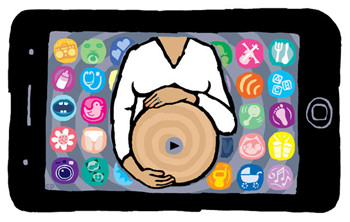(单词翻译:单击)

Three months ago, my wife, Chrysta, and I were driving along Melrose Avenue in Los Angeles when she let out a harrowing cry.
三个月前,我和妻子克里斯塔(Chrysta)开车在洛杉矶梅尔罗斯大道(Melrose Avenue)上行驶时,她突然开始痛苦地哭叫。
I knew exactly what to do: I reached for my iPhone and pressed the bright green “Start” button on the screen and continued to drive as I waited for her to stop wailing.
我清楚地知道自己该怎么做:拿起iPhone,按下屏幕上鲜绿色的“开始”键,继续开车,直到在她停止哭号时按下“结束”键。
The app I was using is called Full Term, which kept track of the length and intervals of her contractions. The app was, as my wife and I learned while rushing to the hospital for the birth of our first child, more useful than we could have ever imagined.
当时我用的应用程序是Full Term,用来记录宫缩的持续时间和间隔时间。它比我们想像的有用得多。我们是在赶去医院生第一个孩子时得知这个应用程序的。
I should preface this by saying that before we downloaded the app (a last-minute recommendation from a friend when I texted: “OMG! We’re in labor!”), I had scoffed at all these baby and pregnancy tools. After all, people have been having babies without apps since the dawn of humanity. Why do we need them now?
我必须先说明一下,在下载这个应用程序(在我给一位朋友发短信说:“天哪!孩子快要生了!”之后,这位朋友在最后关头给我们推荐了这个应用程序)之前,我经常嘲笑这些婴儿和怀孕工具。毕竟,从人类出现起,没有应用程序人们不照样一直在生孩子吗?为什么现在就需要了呢?
Turns out, I was wrong.
结果证明,我之前的想法是错的。
When my wife went into labor, for example, we could have tracked it the old-fashioned way: get a stopwatch, a pen and piece of paper, then jot down the duration of each contraction, and the time in between, and then somehow convey that information to our doctor while my wife endures the most intense pain of her life.
比如,妻子快要分娩时,我们本可以用传统方式进行记录:拿一个秒表、一支笔和一张纸,记下每次宫缩的持续时间和间隔时间,然后在我妻子忍受着生命中最剧烈的疼痛之时,把这些信息以某种方式发给医生。
Or, we could open Full Term (a free app, though $1 donations are welcome) and press a green button to start, and a red one to stop. It gives you a detailed graph of the overall length and how far apart the labor pains are, which I could then text to our doctor. (We later discovered that we showed up at the hospital a tad early, by about 10 hours.)
或者,我们可以打开Full Term(免费的,不过欢迎你捐赠一美元),按绿色按钮开始,按红色按钮停止。它能生成一个详细的图表,展示总时长和产前阵痛的间隔,我可以用短信把它发给医生(后来我们发现自己稍微提前一点到了医院,提前了大约十个小时)。
In addition to the “go bag” that you pack for the hospital, you need a “go folder” of smartphone apps.
除了准备带去医院的“待产包”,你还需要为智能手机上的应用程序建一个“待产文件夹”。
Pregnancy-related apps are not a niche category. According to a 2013 report by Citrix, a software company that tracks app usage, pregnancy-related apps were more popular than fitness apps. And at the Apple iTunes store, four of the top 10 paid medical apps are currently baby-related, including My Baby’s Beat, Baby Connect and Baby Heartbeats.
与怀孕相关的应用程序不再是一个小门类。Citrix是一个追踪应用程序使用情况的软件公司。根据它2013年的一份报告,与怀孕相关的应用比健身应用更受欢迎。在苹果的iTunes商店里,目前排名前十的付费医疗应用程序中有四个与婴儿相关,包括My Baby’s Beat、Baby Connect和Baby Heartbeats。
What do all these apps do? There are apps to help you get pregnant such as My Days and Glow, which help women track their ovulation and fertility. Others track the baby during pregnancy, including BabyBump and Baby Tracker. Still others track the birthing process, including My Birth Plan and Birthing Method. (There’s one for dads called the Guys Guide to the Delivery Room.)
这些应用程序是做什么用的?有帮助你怀孕的,比如My Days和Glow,它们帮助女性记录排卵和受孕。还有记录怀孕期间婴儿状况的,包括BabyBump和Baby Tracker。还有记录分娩过程的,包括My Birth Plan和Birthing Method(还有一款给准爸爸的,叫Guys Guide to the Delivery Room)。
And there are hundreds to help parents after the baby is born.
还有几百个应用程序是帮助父母照顾孩子的。
Before I discovered Full Term, Chrysta downloaded My Pregnancy Today, which shows expectant mothers what’s happening in the womb week by week. (At 12 weeks, the app said, our baby was the size of a lime.)
在我发现Full Term之前,克里斯塔下载了My Pregnancy Today,它能告诉充满期待的准妈妈子宫里每周发生的情况(12周的时候,那个应用程序说,我们孩子的大小跟一颗酸橙差不多)。
During labor, I found that the most useful app was WhatsApp, the messaging platform owned by Facebook. I added friends and family to a group thread, where I shared real-time updates, including audio of the baby’s heartbeat and photos of my wife looking as if she wanted to punch me in the face.
分娩期间,我发现最有用的应用程序是WhatsApp,它是Facebook的一个消息平台。我把朋友和家人加到一个群里,我在那里实时分享最新情况,包括胎儿的心跳音频和妻子的照片——她看起来像是想朝我脸上打一拳。
When our son was finally born, weighing a whopping 8 pounds 5 ounces, we quickly realized we had no idea what we were doing. This is where the app Baby Tracker, $5, came in. You can use it to track how often your baby poops, how much the baby sleeps and, if you’re breast-feeding, how long you feed for. It can also keep track of which breast the baby last fed on, though my wife found it easier to put a rubber band on her wrist.
孩子总算出生了,是个8磅5盎司(约合7.5斤)的大胖儿子。不过,我们很快发现,自己完全不知所措。这时五美元的付费应用程序Baby Tracker登场了。你可以用它来记录你的宝宝多久大便一次,睡了多长时间,如果是母乳喂养的话,喂了多长时间。它还能记录上次吃的是哪一边的乳房,虽然我妻子觉得往喂过奶的那侧手腕上套个橡皮筋更方便。
While your baby’s bowel movements may not seem fascinating at first, you will have riveting conversations about it with your pediatrician. And when you consider that diapers are changed 10 to 12 times a day, that’s the contents of more than 80 diapers a week to keep track of — and to discuss.
虽然刚开始宝宝的排便情况似乎没什么意思,但是你将与儿科医生对它进行多次饶有兴趣的谈话。还有,你想想,纸尿裤一天要换10至12次,那一周就要记80多次,那也是需要讨论的内容。
Now that our son is 3 months old, the app we rely on most is Sound Sleeper, $4 (with a limited free version), which emulates a variety of white noises. Our baby likes to fall asleep to ocean waves, but when he has a meltdown, the only thing that seems to soothe him is the sound of a vacuum cleaner.
现在,儿子三个月大了,我们最依赖的应用程序是四美元(有一个功能有限的免费版)的Sound Sleeper,它能模仿各种白噪音。我们的宝宝喜欢听着大海的波浪声入睡,但是当他情绪失控时,唯一能抚慰他的似乎是吸尘器的声音。
Last week, we discovered a new app called the Wonder Weeks, based on the best-selling book by Frans X. Plooij and Hetty van de Rijt, that details the rapid changes taking place these first weeks of life, and why babies go through “fussy phases.”
上周,我们发现一个新应用,名叫the Wonder Weeks,它以弗兰斯·X·普鲁吉(Frans X. Plooij)和赫蒂·范·德·里特(Hetty van de Rijt)写的畅销书为基础,详细介绍生命前几周里婴儿的快速变化,以及为什么婴儿会经历“烦躁的阶段”。
But there’s one thing I want to make clear. By no means am I suggesting that we give babies iPhones. Many pediatricians, including mine, strongly advise against exposing newborns to the glowing screens of smartphones and tablets. I could not agree more.
但是有一点我得说清楚。我绝不是建议让婴儿看手机。很多儿科医生,包括我的儿科医生,强烈建议不要让新生儿看刺眼的手机和平板电脑屏幕。这一点我非常赞同。
Babies are soaking up the world around them, and their little neurons and synapses are being formed each day. Simple shadows and colors can be overwhelming for some babies. The last thing we want to expose them to are super-bright screens with fast-moving graphics, Additionally, doctors warn that the blue light from screens can reduce melatonin levels, which affects sleep.
婴儿在感受周围的世界,他们小小的神经细胞和突触每天都在形成。简单的阴影和色彩都可能让有些婴儿难以承受。我们最不想让婴儿看到的就是有快速移动图像的超亮屏幕。另外,医生警告说,屏幕的蓝光会降低褪黑素水平,影响睡眠。
Speaking of sleep, I haven’t been able to find an app that helps with sleep deprivation. I’m pretty sure there’s a market for that app, especially among new parents.
提到睡眠,我没找到一款帮助解决父母睡眠不足问题的应用。我确信,那种应用肯定有市场,尤其在新生儿父母中。


